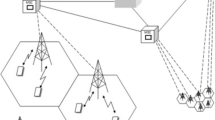Abstract
In cellular wireless networks, the choice of Call Admission Control scheme impacts the performance of the system, particularly as how calls are managed when a mobile user is handed off from one cell to another. Non-prioritized schemes treat handoff calls and new calls equally, while, prioritized schemes give higher priority to handoff calls. In this paper, some of the popular non-prioritized and prioritized Call Admission Control schemes were investigated and their behavior was simulated and analyzed. They are evaluated based on call dropping probability, call blocking probability and system utilization parameters.


















Similar content being viewed by others
References
Abdulova, V., & Aybay, I. (2011). Predictive mobile-oriented channel reservation schemes in wireless cellular networks. Wireless Networks, 17(1), 149–166.
Li, W., Chen, H., & Agrawal, D. P. (2005). Performance analysis of handoff schemes with preemptive and nonpreemptive channel borrowing in integrated wireless cellular networks. Wireless Communications, IEEE Transactions on, 4(3), 1222–1233.
Tekinay, S., & Jabbari, B. (1991). Handover and channel assignment in mobile cellular networks. Communications Magazine, IEEE, 29(11), 42–46.
Li, B., Li, L., Li, B., & Cao, X. R. (2003). On handoff performance for an integrated voice/data cellular system. Wireless Networks, 9(4), 393–402.
Hong, D., & Rappaport, S. S. (1986). Traffic model and performance analysis for cellular mobile radio telephone systems with prioritized and nonprioritized handoff procedures. Vehicular Technology, IEEE Transactions on, 35(3), 77–92.
Pati, H. K. (2013). A control-period-based distributed adaptive guard channel reservation scheme for cellular networks. Wireless Networks, 19(7), 1–15.
Fazio, P., & Marano, S. (2012). A new Markov-based mobility prediction scheme for wireless networks with mobile hosts. In Performance evaluation of computer and telecommunication systems (SPECTS), 2012 international symposium on (pp. 1–5). IEEE.
Hong, D., & Rappaport, S. S. (1989). Priority oriented channel access for cellular systems serving vehicular and portable radio telephones. IEE Proceedings I (Communications, Speech and Vision), 136(5), 339–346.
Somagari, S. R., & Pati, H. K. (2012). An analytical model for adaptive multi-guard channel scheme for multi-class traffic in cellular networks with reduced handoff drop probabilities. Procedia Technology, 6, 690–697.
Martinez-Bauset, J., Gimenez-Guzman, J. M., & Pla, V. (2012). Robustness of optimal channel reservation using handover prediction in multiservice wireless networks. Wireless Networks, 18(6), 621–633.
Oh, S. H., & Tcha, D. W. (1992). Prioritized channel assignment in a cellular radio network. Communications, IEEE Transactions on, 40(7), 1259–1269.
GPSS World Simulation Pakage: http://www.minutemansoftware.com/simulation.htm (last visited: 01.02.2014)
Pavlidou, F. N. (1994). Two-dimensional traffic models for cellular mobile systems. Communications, IEEE Transactions on, 42(234), 1505–1511.
Haung, Y. R., Lin, Y. B., & Ho, J. M. (2000). Performance analysis for voice/data integration on a finite-buffer mobile system. Vehicular Technology, IEEE Transactions on, 49(2), 367–378.
Epstein, B., & Schwartz, M. (1995). Reservation strategies for multi-media traffic in a wireless environment. In Vehicular technology conference, 1995 IEEE 45th (Vol. 1, pp. 165–169). IEEE.
Epstein, B. M. (1999). Resource allocation algorithms for multi-class wireless networks (Doctoral dissertation, Columbia University).
Levine, D. A., Akyildiz, I. F., & Naghshineh, M. (1997). A resource estimation and call admission algorithm for wireless multimedia networks using the shadow cluster concept. Networking, IEEE/ACM Transactions on, 5(1), 1–12.
Ei-Kadi, M., Olariu, S., & Abdel-Wahab, H. (2002). Rate-based borrowing scheme for QoS provisioning in multimedia wireless networks. Parallel and Distributed Systems, IEEE Transactions on, 13(2), 156–166.
Lee, J. Y., Choi, J. G., Park, K., & Bahk, S. (2003). Realistic cell-oriented adaptive admission control for QoS support in wireless multimedia networks. Vehicular Technology, IEEE Transactions on, 52(3), 512–524.
Hofmann-Wellenhof, B., Lichtenegger, H., & Collins, J. (1997). Global positioning system: theory and practice. Springer-Verlag, New York, NY, USA.
Chen, X., Li, B., & Fang, Y. (2005). A dynamic multiple-threshold bandwidth reservation (DMTBR) scheme for QoS provisioning in multimedia wireless networks. Wireless Communications, IEEE Transactions on, 4(2), 583–592.
Banks, J., Carson II, J. S., Nelson, B. L., & D. M. Nicol (2005). Discrete-Event System Simulation, (5th Edn.). Prentice Hall: Pearson Education India.
Author information
Authors and Affiliations
Corresponding author
Rights and permissions
About this article
Cite this article
Abdulova, V., Aybay, I. Performance Evaluation of Non-prioritized and Prioritized Call Admission Control Schemes in Wireless Cellular Networks. Wireless Pers Commun 78, 69–84 (2014). https://doi.org/10.1007/s11277-014-1736-9
Published:
Issue Date:
DOI: https://doi.org/10.1007/s11277-014-1736-9




